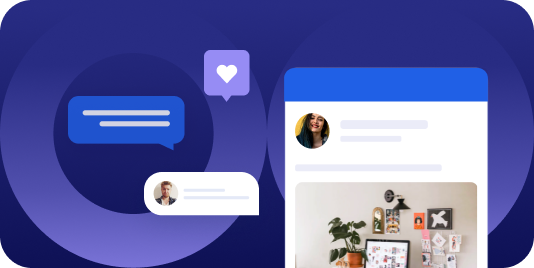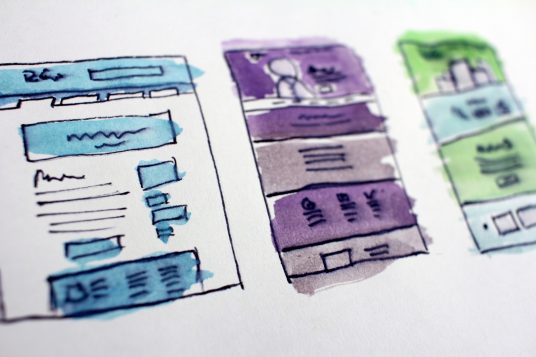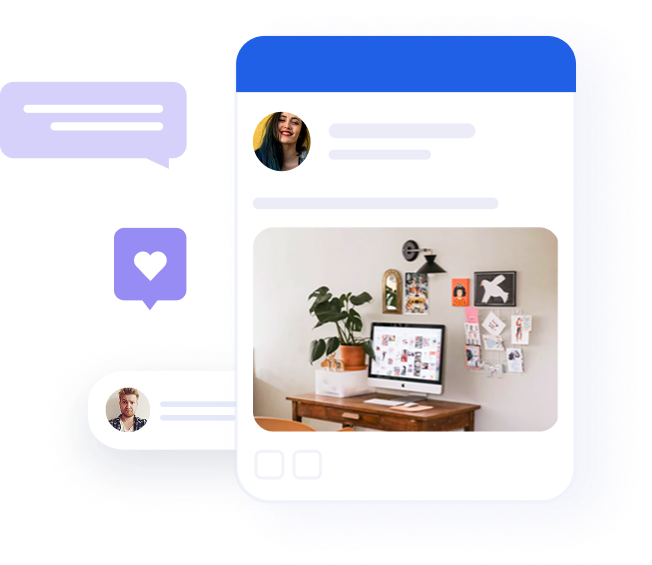
Breaking down social listening for B2B: the full guide
Table of contents
There is no shortage of imperative marketing tactics that if you don’t do right now, your B2B organization will crash and burn. As marketers, we know the MarTech space is crowded. It can be hard to figure out what’s really important, and what are buzzword trends.
We also know the world of social listening is one that can make or break our brand’s reputation.
We have two ears and one mouth for a reason. Like actual listening, social listening can be the glue that holds your marketing strategy together.
In this piece, we’ll break down social listening, how it’s different from social monitoring, and the benefits and ways to use social listening for your B2B brand.
Table of Contents
- What is Social Listening?
- Social Listening vs. Social Monitoring: What’s the Difference?
- Why Social Listening is Important
- 8 Ways to Use Social Listening
- Social Listening Metrics to Track
What is Social Listening?
Social listening is the act of monitoring feeds and platforms for references to your brand, products, competitors, and related keywords, and then taking the extra step to analyze and comprehend what’s being said, who’s saying it, and why, so that you can take action based on that information.
Not so long ago, B2B Marketing was a domain of one-way announcements and sharing your opinion with the world. Before social media, it didn’t matter what channels you used to communicate your message, it was a one way communication channel.
But in 2007, when Chris Messina introduced the hashtag to Twitter, suddenly the conversation became two-way. By 2013, hashtags were exploding and suddenly B2B brands found others beginning to drive messages about their brand rather than the brand driving messages about the brand. Before the rise of social listening tools, B2B marketers would be completely reliant on hashtags and native search on social platforms to get a sense for what people were saying about brands.
However, now that these great brand monitoring tools exist, you can keep a closer eye on what customers, prospects, and employees are saying about you—and what they’re saying about your competitors. You can identify pain points across the board, and control the narrative on how they’re responded to.
This shift created an opportunity for social listening to thrive in a B2B marketing strategy. However, with many B2B marketers leaning heavily on LinkedIn to generate leads, and strong social listening tactics taking place on Twitter, what can B2B marketers gain by social listening?
Learn more about social listening: Listen to the Podcast!
Social listening vs. social monitoring: what’s the difference?
Many times, terms like social listening, social monitoring, and reputation management, are used interchangeably. While there is some overlap between them, there are a few key differences to keep in mind.
Social monitoring is the act of collecting the data centered around your brand, company, and products.
Social listening, however, is what puts that data into perspective. Social listening analyzes the data regarding who published the post, what their intent and sentiment was, and the overall climate of it. Social listening is a form of reputation management, aiming to understand the “why” behind the feedback posted.
Recommended for further reading
Why social listening is important
Social listening also helps you keep tabs on the social media sentiment toward your company and products. Often, when companies become aware of a burgeoning online controversy about themselves, they jump into the fray with statements and responses that seem misguided or out-of-touch because they haven’t taken the time to understand the background issues and context informing the controversy. If you’re really listening, you have a better chance of defining and steering the conversation.
Customers like responsive brands, and more than three-quarters of consumers are more likely to buy from brands they follow on social media. When you listen to your customer base, you can engage in ways that feel authentic instead of forced, increasing acquisitions and gaining valuable insights along the way.

You might also discover influencers in your market and industry while they’re just starting to make a name for themselves, giving you the chance to develop beneficial relationships with trusted voices.
8 ways to use social listening
1. Reputation management
You can’t put a price on the real-time perception of your brand. Social listening allows you to understand how customers, prospects, and partners feel about your brand.
Not only does this help you understand what you’re doing well and where you need improvement, it shows you what your customers and your prospects are looking for. Everything in any kind of commerce and marketing boils down to pain points and how your brand alleviates them. Understanding what your customers and prospects need to alleviate helps you stay a step ahead of their needs.
2. Competitor analysis
Some years ago, while working with a SaaS company, we closed out our Friday with a press release from our biggest competitor. This competitor regrettably informed its customers that it would no longer be integrating with one of the most popular platforms many of them used for day-to-day operations.
Naturally, we spent the weekend responding to anyone and everyone who was talking about it with empathy, and making sure they knew we, a company that still integrated with the platform, were available to help them.
How did we know to be in the right place at the right time? Social listening.
In much the same way that you can use social listening to monitor your own brand, using it to also monitor your customers can present unique opportunities to be where your competitors are, and where they’ve chosen not to be.
Look at what their customers’ pain points are. Can you alleviate any of them? You may not respond directly to tweets and social posts talking about those pain points (it might turn off a potential customer), instead, you might add those pain points and your solution to them into your communication.
3. Engaging customers
Social listening gives you the opportunity to discover and monitor conversations that pertain to your brand and product, whether they’re by your own customers or by those who might be your customers one day.
There’s a great opportunity to get your brand in front of new eyes. However, it might not be a good idea to immediately spam your offer all over a post. Instead, try contributing value to the conversation, offer a blog post, or a video you’ve created. It’s a great way to show people that you care about the conversation and topic, as opposed to them feeling like you only care about their wallets.
4. Avoiding social media crises
Negative feedback and mistakes are a fact of life—and getting ahead of them can be the difference between quietly fixing a situation and experiencing a full-scale social media crisis.
However, sometimes some situations snowball before you get that opportunity, even with social listening. In that case, you’ll need a social media response plan in place to manage that feedback in a way that doesn’t cause things to get worse.
Check out our social media response template for help creating your own policy.
5. Identifying prospects
When people are talking about your products, services, competitors, or your industry, and you engage with that conversation, naturally, it helps you identify prospects extremely well. You learn what potential customers are thinking about and their biggest challenges at work.
Oftentimes, social listening can be considered a prerequisite for social selling because as you engage, you begin to identify your potential customers’ needs and how you, or your solution, may be able to help them.
By listening across both LinkedIn and Twitter, you can find ways to best help people at scale– and then help them.
6. Developing product roadmap
If you understand what your target audience is worried about and talking about by listening on social media– it helps you to prioritize features and products in your roadmap. When you follow trends around a certain topic, or a specific hashtag, you start to understand:
- What people are worried about
- What tools they are using
When we know these concerns exist for businesses, we can put out messaging and content towards these concerns. This is how a business can listen on social media and prioritize what to develop on their roadmap.
7. Plugging sales funnel leaks
“Hello, I’m using X product, but I think I’d like to switch to Y or Z product. Does anyone have experience with them?”
Whether you’re product X, Y, or Z, knowing this conversation is happening on social is a great way to control the narrative. You can respond, and have account executives pop by and offer resources to help the prospect make their decision.
8. Understanding shifting trends
Now more than ever, trends are shifting faster than the speed of light. A social listening strategy gives organizations the ability to step out of their echo chamber and go beyond listening internally. Listening externally gives stakeholders of the organization the ability to impact decisions that will affect the organization not just in the short-term, but 5-10 years down the road.
Unlike B2C organizations who are often using social listening tactics to determine their product lining for the next season, B2B organizations need to see what’s going on and how shifting trends may or may not impact decision-making and planning. For instance, one trend right now is artificial intelligence. Many marketing leaders are keeping a pulse on how AI may impact the way their teams do work. While theories and trending topics may not materialize in the near future, you can certainly make better decisions as a stakeholder for the long haul by using social listening data in your decision-making.
Social listening metrics to track
Share of voice
Share of voice is the amount of real estate your brand holds around a certain topic. For example, if you’re a CRM SaaS company, you might be looking for the amount of posts that refer to your brand on social media as opposed to your competitors.
This is a particularly helpful metric around branding, and understanding where you measure up to your competition.
Sentiment analysis
Sentiment analysis essentially uses machine learning to understand the general context of the posts around a particular topic. As with anything involving machine learning, it’s not perfect, but gets better as it analyzes more data.

That said, a sentiment analysis can help you understand how people are feeling at a glance. There are some things that won’t be caught, like sarcasm and mixed statements. You can always course-correct sentiment analysis as you’re tracking it.
Conversion rate & ROI
As with any channel, conversion rate and, by extension, ROI are going to be the main metrics to track. How can you determine social listening conversion rate?
Simply consider the actions you take as a result of your social listening. Did it provoke a new white paper on customer pain points? Did you participate in a conversation that led to a qualified lead or even a customer? Did the information you collected impact your sales funnel in some way?
It might be a bit trickier to track, but it’s definitely a good way to see if you’re using the information you’ve gathered to its full potential. Luckily, there are also great ways to make social listening measurable from a conversion standpoint.
Key social listening takeaways
While it is true that historically, B2C organizations have put more focus on social listening than B2B companies because stated simply, that’s where a lot of volume of conversations to understand their consumers were taking place, the game has changed when it comes to B2B.
With many B2B organizations humanizing their marketing approach and understanding that social media has made room for two-way conversations with prospects and customers, social listening has become a critical component of a successful marketing strategy.
At the end of the day, while B2B is “business to business,” there are people behind the businesses that B2B marketers are trying to influence. And the best way to understand and influence people has always been through listening. Social media now gives marketers the ability to listen to people and help them make a decision.



